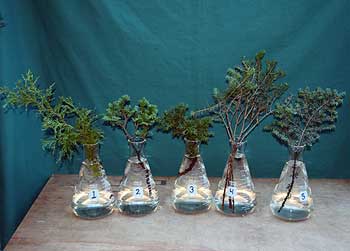December Color Appears at the Washington Park Arboretum
Conifer trees occasionally mutate into unusual forms, often slow-growing natural dwarfs. Thousands of these have been in cultivation for centuries. The Arboretum has only a few in its collection, sadly neglected in grid 37-1W – a corner of the Oaks area. Here are five examples:

Rare Care
1) Chamaecyparis lawsoniana ‘Lycopodioides’
- Translated: “a form of Lawson’s false cypress that looks like Lycopodium” – a genus of club moss that’s said to resemble a wolf’s foot.
2) Chamaecyparis pisifera ‘Plumosa Nana’ Dwarf Sawara Cypress cv.
- Dwarf (nana), feathery (plumose), pea-bearing (pisifera) false cypress
3) Cryptomeria japonica ‘Bandai-Sugi’ Japanese Cedar cv.
- The cultivar name has been shortened recently to ‘Bandai’ because Sugi is the Japanese word for Cryptomeria, therefore is redundant.
- All parts of the flower are hidden in this genus, hence Crypto (hidden) meria (parts).
4) Picea abies ‘Gregoryana parsonii’ Norway Spruce cv.
- See Arthur Lee Jacobson’s Trees of Seattle for an explanation of the botanic name.
- Jacobson notes that only Lawson’s Cypress has more cultivars than Norway Spruce.
5) Tsuga canadensis ‘Hussii’ Eastern Hemlock cv.
- Because of people’s tendency to call all conifers “pine” or “fir”, botanists adopted the Japanese name for hemlocks – Tsuga. Does that sound too similar to ‘Sugi’?